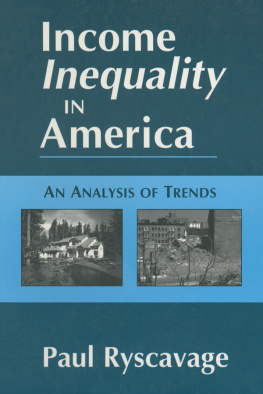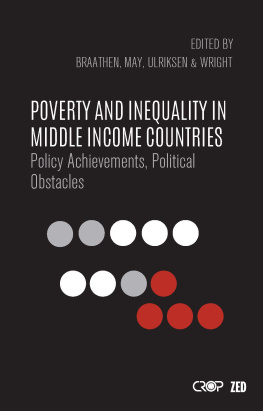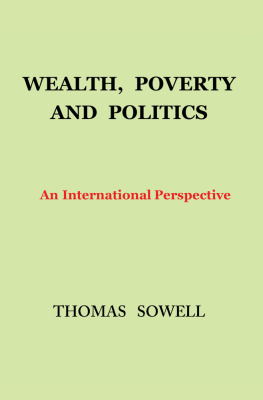Income
Inequality
IN
America
ISSUES IN WORK AND HUMAN RESOURCES
Daniel J. B. Mitchell, Series Editor
WORKING IN THE TWENTY-FIRST CENTURY
Policies for Economic Growth Through Training, Opportunity, and Education
David I. Levine
INCOME INEQUALITY IN AMERICA
An Analysis of Trends
Paul Ryscavage
HARD LABOR
Poor Women and Work in the Post-Welfare Era
Joel F. Handler and Lucie White
Income
Inequality
IN
America
AN ANALYSIS OF TRENDS
Paul Ryscavage

First published 1999 by M.E. Sharpe
Published 2015 by Routledge
2 Park Square, Milton Park, Abingdon, Oxon OX14 4RN
711 Third Avenue, New York, NY 10017, USA
Routledge is an imprint of the Taylor & Francis Group, an informa business
Copyright 1999 Taylor & Francis. All rights reserved.
No part of this book may be reprinted or reproduced or utilised in any form or by any electronic, mechanical, or other means, now known or hereafter invented, including photocopying and recording, or in any information storage or retrieval system, without permission in writing from the publishers.
Notice
No responsibility is assumed by the publisher for any injury and/or damage to persons or property as a matter of products liability, negligence or otherwise, or from any use of operation of any methods, products, instructions or ideas contained in the material herein.
Practitioners and researchers must always rely on their own experience and knowledge in evaluating and using any information, methods, compounds, or experiments described herein. In using such information or methods they should be mindful of their own safety and the safety of others, including parties for whom they have a professional responsibility.
Product or corporate names may be trademarks or registered trademarks, and are used only for identification and explanation without intent to infringe.
Library of Congress Cataloging-in-Publication Data
Ryscavage, Paul.
Income inequality in America: an analysis of trends / Paul Ryscavage.
p. cm.(Issues in work and human resources)
Includes bibliographical references and index.
ISBN 0-7656-0233-4 (hardcover: alk. paper).
ISBN 0-7656-0234-2 (pbk.: alk. paper)
1. Income distributionUnited States. I. Title.
HC110.I5R95 1998
339.220973dc21
98-23186
CIP
ISBN 13: 9780765602343 (pbk)
ISBN 13: 9780765602336 (hbk)
For my wife
Karen
whose encouragement and understanding
are never-ending
Contents
Tables
Figures
Income inequality has become a major policy concern. The rise in inequality, by various measures, invokes an image of a society divided between haves and have-nots. In turn, that image suggests the possibility of eventual political repercussions and, perhaps, social unrest. Will events such as the Los Angeles riots of 1992 become a feature of the American scene? At a less dramatic level, the rise in inequality suggests revisiting such long-standing policies as welfare programs, minimum wage laws, and laws that regulate collective bargaining. And it leads to examination of new programs, such as living wage ordinances, applicable to contractors of municipal governments.
In this volume, Paul Ryscavage reviews the various indexes of income inequality. Unfortunately, there is no one theoretically correct measure of the concept of inequality. Thus, it is best to look at several measurement tools and approaches. Even the definition of income must be examined. Apart from money income, individuals may receive various in-kind subsidies from government programs. And they may receive non-wage benefitssuch as health insurancefrom employers. The fact that all approaches to measurement suggest widening inequality is important, since it allows discussion to proceed to factors associated with this trend.
Finding an explanation for the widening of inequality after the early 1970s has challenged economists and other researchers. International trade competition, especially in products that displace low-skilled/low-wage workers is a commonly cited candidate for causing widened inequality. The trade argument has been echoed across the political spectrum by presidential candidates as varied as Pat Buchanan, Ross Perot, Richard Gebhardt, and Jerry Brown. But many scholars believe changing technology, which moves demand away from those at the bottom of the wage scale, is a more significant factor. This debate has yet to be resolved.
What is known, Ryscavage points out, is that there have been fluctuations in income inequality before the postWorld War II period. It appears the Great Depression and World War II were periods in which inequality diminished after peaking in the 1920s. The rise of unions and the inauguration of various social programs in that era seemed to coincide with a compression of the income distribution. Indeed at the time, many in the New Deal administration believed that income inequality had contributed to insufficient consumption by wage earners and thus sparked or aggravated the Depression.
Since there has been no Great Depression associated with current inequality, trade remains a popular villain, even if academics often downplay its significance. Given the popularity of trade-as-a-villain in income inequality, it is useful to examine cross-country trends. If there is an international influence, its impact should be visible in developed countries outside the United States. Inequality did increase in many (but not all) countries beginning in the 1970s. But the degree to which inequality rose varied by country. And the United States seemed to be taking the lead in the pace of the rise. Institutional arrangements may well play a role. Some observers have noted that the United States also led in job creation during this period, suggesting that countries may resist widening inequality but at a social and economic cost in unemployment.
If there is a bright spot in this review of inequality, it is Ryscavages evidence that the American trend toward rising inequality diminished in the 1990s. Thus, the social tensions that might follow from a further widening of the income gap may be at least arrested. Unfortunately, at this point it is impossible to predict that a turnaround point, or even a stopping point, has been reached. But what can be done is to provide accurate and comprehensive documentation of what has occurred and that is something this volume surely does with finesse.
Daniel J. B. Mitchell
This book is about the incomes of persons, families, and households and the relationship of their incomes to one another. The way this relationship is observed in this book is through an income distribution in which incomes are ranked from the lowest to the highest. As is commonly known today, the United States income distribution has become more dispersed in recent years, that is, the distance between the lower and upper parts of the distribution has grown.
The growth in income inequality has attracted much attention from various segments of our society. The media have reported on the issue extensively, often from the standpoint of fairness, or how the nations economic prosperity of recent decades has not been shared by everyone. Politicians, sensing the unease over growing income inequality from members of their constituencies, have debated the significance of this economic development.
Economists, and other social researchers, have also focused on the growth in income differences in the United States over the past years. While the vast majority of them today agree that income inequality (and earnings inequality) has grown, there is still disagreement over the cause or causes. Countless studies have explored various explanations and many important insights have been gained. Unfortunately, for persons not that familiar with income and earnings data and the methodologies used by researchers in investigating inequality, their studies and research are oftentimes difficult to understand. For persons such as beginning economics students and others with a serious interest in the topic, it is obvious that there is a need for a primer on income inequality.







